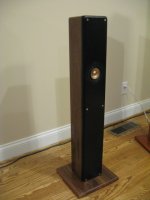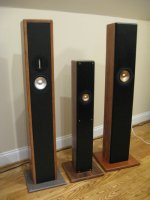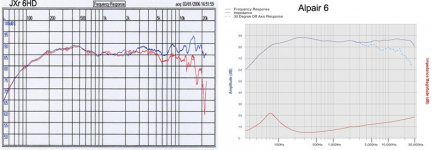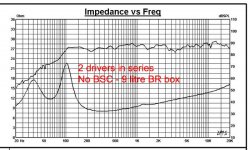Recently I reported on a new MLTL design with the new Mark Audio Alpair 10 (A10) full range driver. Concurrent with the A10 activity I also developed a MLTL using the Alpair 6 (A10) driver. The Alpair 6 is constructed much like the A10 variant with a heavy composite polymer frame surrounding the spun aluminum cone. Both the A10 and A6 drivers have the large diameter round frame which is 4.5” diameter for the A6. The cone disk of the A6 is only approximately 6 cm (2.36”) diameter so we are talking about a very tiny driver. As with the A10 model the A6 cone is attached via a concave surround versus the usual top mounted convex surround. The A6 is a 4 ohms driver so some amplifiers may not be able to handle this impedance.
Normally you would think of the small A6 driver as a small surround speaker or perhaps a desktop computer monitor application. The SPL output for the A6 is specified to be 86 dB so we aren’t talking about public address usage because even with a one way Xmax of 5 mm you aren’t moving much air. But often small speakers will suffice for smaller rooms and less intrusive use—aka more SAF friendly speakers. In this case I decided to push the limits a bit and just see what the A6 could do in a full range MLTL. The A6 MLTL design was developed with help from Martin J. King’s excellent worksheets. With the MJK worksheets the design process develops by entering the T/S parameters of the driver and a set of starting dimensions for the box and driver to port locations. Then you iterate the dimensions to achieve a desired response. I had a starting point from my ‘Smart as a Fence Post MLTL’ project which was derived a few years ago for Tang Band 3” drivers. For the A6 I settled upon a design with an F3 of 45 Hz for the low frequency response. The port is tuned to 51 Hz. Lengthening the port tube from 3” to 4” will lower the port tuning and the F3 point a couple of Hz’s with minimal frequency response changes.
My Alpair 6 MLTL prototypes were built from solid walnut hardwood for the sides and top with MDF for the front, back, and bottom panels of the box. The overall external box dimensions for my enclosure (with 0.75” thick material) are 35.25” H x 5.5” W x 5.5” D. I am using a false bottom to raise the driver to be closer to listening height.
In this case the active part of the MLTL internal dimensions are: length (top to bottom) 30”, driver distance from the top 10”, port distance from the top 27”, with a straight cross-sectional area of 4” wide x 4” deep, stuffing density of 0.50 lbs per cubic feet, and port radius of 0.75 inches with a port length of 4”. The false bottom adds 5.25” to attain the height of the finished box. I have added flush mounted embedded magnets in the front baffle face for grill attachment.
From the conception I knew that these speakers would sound acceptable with good music at moderate volume. I suspected that they would strain when pushed toward their limits. Well, color me surprised at just how impressive these little guys sound on favorite tracks. The speakers can be run without any baffle step filtering as there is some help from their frequency response. If you observe Mark Audio published frequency response for the A6 you’ll notice that the driver has a hump of up to 3-4 dB in the 175-550 Hz range. Thus, for the 5.5” wide cabinets there is some inherent gain in this area for baffle step compensation.
Now these speakers will not win any bass SPL contests but you’ll be impressed at how well they perform. Vocals are natural with no sibilance for both male and female voices. The high frequencies are very nice with the shimmer of cymbals and such.
So in conclusion these little guys get the job done for the size and satisfy the SAF goals that I had established. Don’t expect wall shaking performance but a solid reproduction of music in a small/mid-sized is delightful.
Normally you would think of the small A6 driver as a small surround speaker or perhaps a desktop computer monitor application. The SPL output for the A6 is specified to be 86 dB so we aren’t talking about public address usage because even with a one way Xmax of 5 mm you aren’t moving much air. But often small speakers will suffice for smaller rooms and less intrusive use—aka more SAF friendly speakers. In this case I decided to push the limits a bit and just see what the A6 could do in a full range MLTL. The A6 MLTL design was developed with help from Martin J. King’s excellent worksheets. With the MJK worksheets the design process develops by entering the T/S parameters of the driver and a set of starting dimensions for the box and driver to port locations. Then you iterate the dimensions to achieve a desired response. I had a starting point from my ‘Smart as a Fence Post MLTL’ project which was derived a few years ago for Tang Band 3” drivers. For the A6 I settled upon a design with an F3 of 45 Hz for the low frequency response. The port is tuned to 51 Hz. Lengthening the port tube from 3” to 4” will lower the port tuning and the F3 point a couple of Hz’s with minimal frequency response changes.
My Alpair 6 MLTL prototypes were built from solid walnut hardwood for the sides and top with MDF for the front, back, and bottom panels of the box. The overall external box dimensions for my enclosure (with 0.75” thick material) are 35.25” H x 5.5” W x 5.5” D. I am using a false bottom to raise the driver to be closer to listening height.
In this case the active part of the MLTL internal dimensions are: length (top to bottom) 30”, driver distance from the top 10”, port distance from the top 27”, with a straight cross-sectional area of 4” wide x 4” deep, stuffing density of 0.50 lbs per cubic feet, and port radius of 0.75 inches with a port length of 4”. The false bottom adds 5.25” to attain the height of the finished box. I have added flush mounted embedded magnets in the front baffle face for grill attachment.
From the conception I knew that these speakers would sound acceptable with good music at moderate volume. I suspected that they would strain when pushed toward their limits. Well, color me surprised at just how impressive these little guys sound on favorite tracks. The speakers can be run without any baffle step filtering as there is some help from their frequency response. If you observe Mark Audio published frequency response for the A6 you’ll notice that the driver has a hump of up to 3-4 dB in the 175-550 Hz range. Thus, for the 5.5” wide cabinets there is some inherent gain in this area for baffle step compensation.
Now these speakers will not win any bass SPL contests but you’ll be impressed at how well they perform. Vocals are natural with no sibilance for both male and female voices. The high frequencies are very nice with the shimmer of cymbals and such.
So in conclusion these little guys get the job done for the size and satisfy the SAF goals that I had established. Don’t expect wall shaking performance but a solid reproduction of music in a small/mid-sized is delightful.
Attachments
Henry,
I haven't listened enough to these new speakers to make a final decision as to which one is better than the other. However, my inital impressions are that the Alpair 6 has less bass potential vs. the A10 while the A6 seems to have better high end dispersion. These are size related issues. If I had to have only one then the A10 would likely be a safe choice, but the A6 has a cuteness factor that is hard to ignore.
Both drivers seem to be well controlled with a neutral sound thoughout frequency so you can listen to them all day. No issues that cause your ears to fatigue with time. They are keepers.
Jim
I haven't listened enough to these new speakers to make a final decision as to which one is better than the other. However, my inital impressions are that the Alpair 6 has less bass potential vs. the A10 while the A6 seems to have better high end dispersion. These are size related issues. If I had to have only one then the A10 would likely be a safe choice, but the A6 has a cuteness factor that is hard to ignore.
Both drivers seem to be well controlled with a neutral sound thoughout frequency so you can listen to them all day. No issues that cause your ears to fatigue with time. They are keepers.
Jim
EUVL,
I also have a MLTL design for the Jordan JX92S with a ribbon tweeter (Aurum Cantus G2si) that I really like. That design is a variant of my earlier mini-monitor design,
The MLTL designs for the Alpair 6 and 10 offer the advantage of bass extension in a small footprint. I think of these speakers as small monitors on a stand whereas the stand is the MLTL pipe.
Pictured are the 'Jordan with a Ribbon' MLTL, the Alpair 6 MLTL, and the Alpair 10 MLTL.
Jim
I also have a MLTL design for the Jordan JX92S with a ribbon tweeter (Aurum Cantus G2si) that I really like. That design is a variant of my earlier mini-monitor design,
The MLTL designs for the Alpair 6 and 10 offer the advantage of bass extension in a small footprint. I think of these speakers as small monitors on a stand whereas the stand is the MLTL pipe.
Pictured are the 'Jordan with a Ribbon' MLTL, the Alpair 6 MLTL, and the Alpair 10 MLTL.
Jim
Attachments
I know it is a bit off topic, but how would you have done a BR for AP6?
6.3 litres with a pipe of say 36mm dia x 100mm long ?
Mark (from Markaudio) seems to like a very small box (3.x litres).
Maybe there is some trick that I do not quite get as yet.
Patrick
BTW your MLTLs look gorgous.
Just that I am looking to use AP6 for desk top.
6.3 litres with a pipe of say 36mm dia x 100mm long ?
Mark (from Markaudio) seems to like a very small box (3.x litres).
Maybe there is some trick that I do not quite get as yet.
Patrick
BTW your MLTLs look gorgous.
Just that I am looking to use AP6 for desk top.
Just to second Jim's findings.
I've been using the Jordan JXR6HD for some time now in a straightforward sealed box. A house revamp means they stood in for my JX92 MLTLs for a while and ... I haven't got round to swopping them back. With a sub they seem to do well as my main system.
Sadly the JXR6s are not suited to MLTL enclosures (they need a sealed enclosure) but I can appreciate how well Jim's Alpair 6 MLTL will sound.
TheJXR6s work even better when doubled up. That may be overkill with the Alpair 6 due to the mid-bass hump Jim mentioned.
I've been using the Jordan JXR6HD for some time now in a straightforward sealed box. A house revamp means they stood in for my JX92 MLTLs for a while and ... I haven't got round to swopping them back. With a sub they seem to do well as my main system.
Sadly the JXR6s are not suited to MLTL enclosures (they need a sealed enclosure) but I can appreciate how well Jim's Alpair 6 MLTL will sound.
TheJXR6s work even better when doubled up. That may be overkill with the Alpair 6 due to the mid-bass hump Jim mentioned.
Re Collin's comments on the 6HD and Alpair 6:
The "hump" is also present in the 6HD's low-mid performance, relatively similar to the alpair 6. This HD result is from a batch we made in late 2006. I can't speak for any 6HD units that may have been produced after we parted from Jordan some months later.
I didn't have the time to test the HD's that we made in sealed boxes, but maybe the variations in the lower frequencies would be damped in smaller sealed boxes for both drivers. I'd have to test an Alpair 6 in our anechoic chamber to be sure (when time permits!)
Cheers,
Mark.
The "hump" is also present in the 6HD's low-mid performance, relatively similar to the alpair 6. This HD result is from a batch we made in late 2006. I can't speak for any 6HD units that may have been produced after we parted from Jordan some months later.
I didn't have the time to test the HD's that we made in sealed boxes, but maybe the variations in the lower frequencies would be damped in smaller sealed boxes for both drivers. I'd have to test an Alpair 6 in our anechoic chamber to be sure (when time permits!)
Cheers,
Mark.
Attachments
Hi Mark
I haven't noticed any emphasis in that region with the JXR6 but it does sound more balanced when either used close to a wall or, if free standing, used with a second unit. I assume that provides the sort of balance normally achieved with BSC. Either way, very impressive driver, ideal for unobstrusive surround use. I hope to hear the Alpair 6 sometime.
I haven't noticed any emphasis in that region with the JXR6 but it does sound more balanced when either used close to a wall or, if free standing, used with a second unit. I assume that provides the sort of balance normally achieved with BSC. Either way, very impressive driver, ideal for unobstrusive surround use. I hope to hear the Alpair 6 sometime.
Hi Patrick,
I had the idea for a neat simple desktop that could also double as a small room system if needed. Really interesting to hear what can be delivered in the way of LF from a small package. Mark (L) was impressed when he listened to the 3 litre boxes.
I've had many emails saying box software thinks the Alp 6 will play well in sizes up to 6 litres.
Essentially, my thinking is that any small drivers (cone dia. around 2" - 50-60-mm ish)with reasonable excursion, Vas above 2.5 litres, and total Q in the region of .42 to .6 usually can work well in a mini sized BR.
Cheers,
Mark
Yep -I'm tuckered, surviving on 4 hours sleep, tonnes to do!
I had the idea for a neat simple desktop that could also double as a small room system if needed. Really interesting to hear what can be delivered in the way of LF from a small package. Mark (L) was impressed when he listened to the 3 litre boxes.
I've had many emails saying box software thinks the Alp 6 will play well in sizes up to 6 litres.
Essentially, my thinking is that any small drivers (cone dia. around 2" - 50-60-mm ish)with reasonable excursion, Vas above 2.5 litres, and total Q in the region of .42 to .6 usually can work well in a mini sized BR.
Cheers,
Mark
Yep -I'm tuckered, surviving on 4 hours sleep, tonnes to do!
Hi Collin,
Good to hear from you ((long time).
I did much work on coils in the early days. Different former materials gave varying results across the HD's range. I applied my experiences form the energy transmission industry in dealing with the factors that apply to operational relationships between drivers and their box environments. I've carried this knowledge on into my family of drivers. I've refined the technique to help reduced the need for BSC.
Here's an interesting graph from my other work show showing a flat response using 2 drivers in series in a 9 litre BR box (No BSC).
The HD's maybe benefiting from the same flattening effect, the driver's LF gain is off-setting the pneumatic inertia inside the box.
Also, the HD's suspension are very soft damped, there's no spider so pairing then helps to spread the work load. Room gain is welcomed, again reducing the need to increase the loads on each driver.
Cheers,
Mark
Good to hear from you ((long time).
I did much work on coils in the early days. Different former materials gave varying results across the HD's range. I applied my experiences form the energy transmission industry in dealing with the factors that apply to operational relationships between drivers and their box environments. I've carried this knowledge on into my family of drivers. I've refined the technique to help reduced the need for BSC.
Here's an interesting graph from my other work show showing a flat response using 2 drivers in series in a 9 litre BR box (No BSC).
The HD's maybe benefiting from the same flattening effect, the driver's LF gain is off-setting the pneumatic inertia inside the box.
Also, the HD's suspension are very soft damped, there's no spider so pairing then helps to spread the work load. Room gain is welcomed, again reducing the need to increase the loads on each driver.
Cheers,
Mark
Attachments
Jim sent us his plan for the MLTL using the Alpair 6 (round frame) full range driver.
He's kindly given his consent to share the design to help DIY builders.
Here's Jim's suggestion on damping the box:
"The stuffing density is 0.5 pound per cubic foot. In my prototypes I used Acousta Stuf(Trademark) damping fiber but similar material will suffice. The stuffing should extend from below the driver to the top of the box. I place a coarse metal grid or screen on top of the internal brace to prevent the stuffing from falling below the brace and tease the material as I fill the cavity. No stuffing is placed below the internal brace"
PDF attached for downloading.
Cheers,
Mark.
He's kindly given his consent to share the design to help DIY builders.
Here's Jim's suggestion on damping the box:
"The stuffing density is 0.5 pound per cubic foot. In my prototypes I used Acousta Stuf(Trademark) damping fiber but similar material will suffice. The stuffing should extend from below the driver to the top of the box. I place a coarse metal grid or screen on top of the internal brace to prevent the stuffing from falling below the brace and tease the material as I fill the cavity. No stuffing is placed below the internal brace"
PDF attached for downloading.
Cheers,
Mark.
Attachments
I have been playing around with the Alpair 6 in a small BR box. Box volume is 5.55L and is tuned to around 62Hz. I am also working on a MLTL similar to Jim's but slightly larger. I have Augsberger's program and came up with some dimensions independantly. The MLTL is not ready yet, but I have a prototype of the BR box going. After a few hiccups, the little boxes are really singing beautifully in the lounge room. Midrange is special, close to electrostatic quality. I have an electrostatic so this is no BS. Placed close to a wall or in a corner these are special little speakers that have midrange clarity and detail I can't recall ever hearing before in a dynamic driver. They do take a long time to run in, and there is quite a big difference in the sound as they get run in - sweeter and sweeter. Mine are not fully run in yet, but the treble has certainly got a lot sweeter from the raw new driver. Not quite up to electrostatic standard, my electrostatic is definately cleaner in the treble, but the treble would beat a lot of the domes I have wasted a lot of money on. I can't hear any trace of sibilance. All in all a lovely smooth neutral sound with great clarity and detail.
These little BR boxes have vey high WAF. SHMBO loves them. I am going to make another pair from solid timber and they will be even more acceptable to the boss. In fact she said this morning - "See, you can get good sound from little speakers, don't BS me. Those electrostatics are way TOO BIG". Groan. Married blokes beware, they are cute and work best in places women like to dump speakers.
Anyway, the Alpair 6 are definately keepers. Very nice indeed, I'm impressed. When I get the MLTL up and running and the BR in solid wood I will put up some pictures.
These little BR boxes have vey high WAF. SHMBO loves them. I am going to make another pair from solid timber and they will be even more acceptable to the boss. In fact she said this morning - "See, you can get good sound from little speakers, don't BS me. Those electrostatics are way TOO BIG". Groan. Married blokes beware, they are cute and work best in places women like to dump speakers.
Anyway, the Alpair 6 are definately keepers. Very nice indeed, I'm impressed. When I get the MLTL up and running and the BR in solid wood I will put up some pictures.
- Status
- This old topic is closed. If you want to reopen this topic, contact a moderator using the "Report Post" button.
- Home
- Loudspeakers
- Full Range
- Small MLTL for Mark Audio Alpair 6 Drivers



